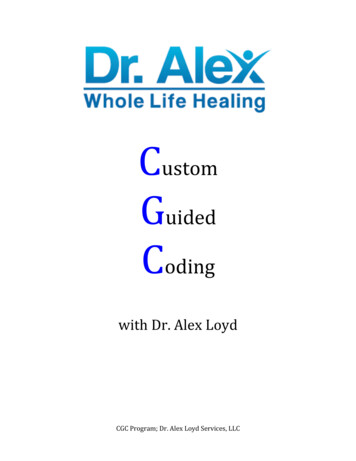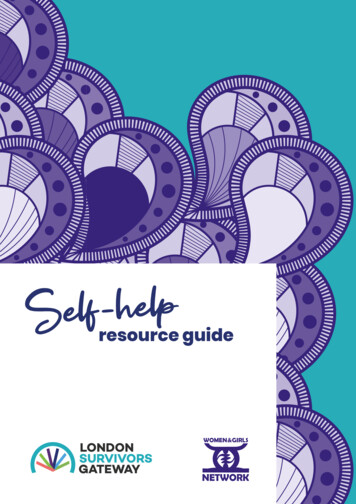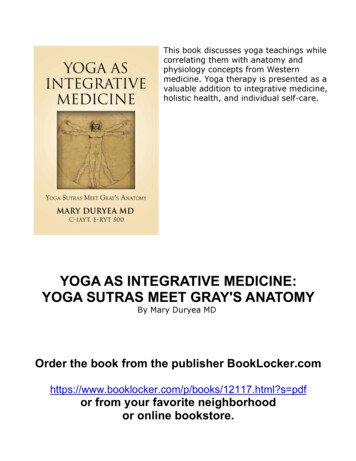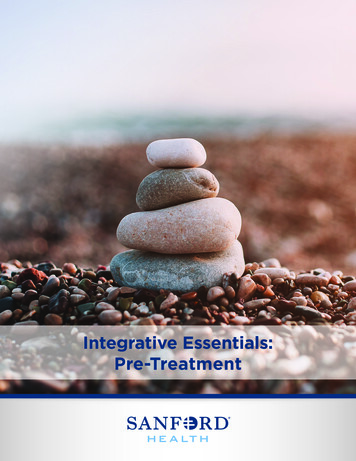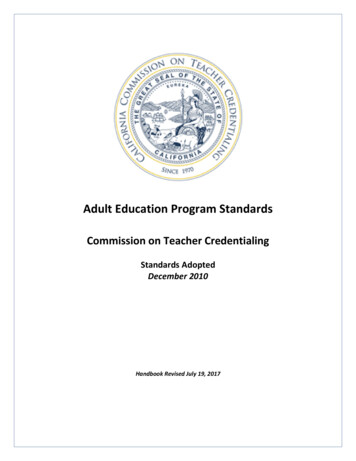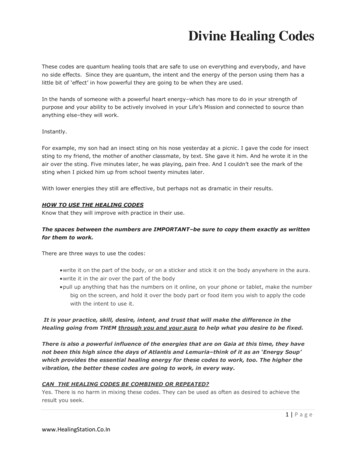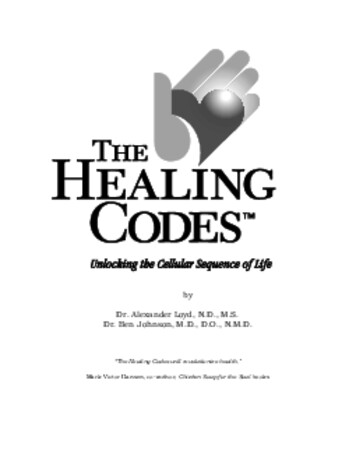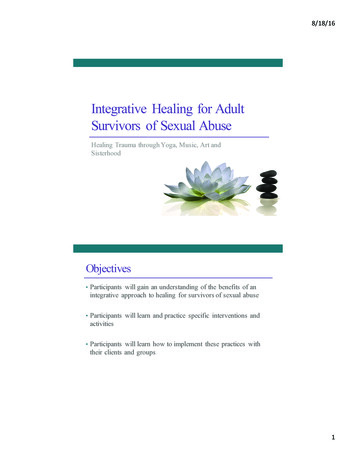
Transcription
8/18/16Integrative Healing for AdultSurvivors of Sexual AbuseHealing Trauma through Yoga, Music, Art andSisterhoodObjectives Participants will gain an understanding of the benefits of anintegrative approach to healing for survivors of sexual abuse Participants will learn and practice specific interventions andactivities Participants will learn how to implement these practices withtheir clients and groups1
8/18/16PresentersErika B. Brosig, CA, MS, LSWSupervisor of Direct ServicesCambria County SART CoordinatorReiki Master/TeacherVictim Services Inc.ebrosig@cambriasomersetvs.orgRachel Allen, ERYT200Trauma Sensitive Yoga TeacherCertified Music PractitionerReiki Master/TeacherYoga itive Yoga Program A collaboration between Victim Services Inc., Yoga Song, Women’s Help Center, andthe Bottle Works Arts on 3 rd Avenue Funded through grants, donations, and fundraisers Components Support Group Expression through Visual Art Musical Expression Through Mantra Trauma-Sensitive Yoga Practice Location Neutral, safe, and confidential facility Invites people to be part of a larger community Participants come early to see the changing exhibits 2 from our current group have signed up to volunteer2
8/18/16Programs Weekly trauma sensitive yoga classes for survivors Started in Spring 2016 Free for survivors of sexual assault and domestic violence 10-week program – adult women Piloted in 2013 Weaves yoga philosophy into support group and yoga and mantra practice Expressive art exercise at first and last session Public art opening and traveling exhibit Currently seeking fundingWhy Use An Integrative Approach? Talk therapy/counseling only go so far – while an essential partof healing for many survivors, there are areas that cannot bereached with therapy/counseling alone Musical expression allows survivors to findtheir voice again after years of silence Expression through art accesses bothhemispheres of the brain and for manysurvivors can become an additional copingskill3
8/18/16Neurobiology of TraumaEffects of Trauma After effects of sexual trauma create disruptions in the physicalbody, in the nervous system and the emotions Freezing, muscle memory and body armor in PosttraumaticStress Disorder (PTSD) Reaction to trauma excludes us from having new experiencesreach our inner world Survivors of trauma lose a sense of self (psychologically andphysically)4
8/18/16Neurobiology of the Traumatized Brain In traumatized states, the language area of the brain shuts down and theability to process verbally is challenged Brain areas associated with self regulation and planning are compromised Brain responses lose synchronicity with environment and daily rhythms(sleep, eating, social rhythms) are thrown off The fundamental experience of trauma is not being able to be here in thepresent moment because in the neurobiology of the traumatized brain,the present moment is intolerable. The past and the trauma is thedominant reality (van der Kolk) BARCC Yoga Program ManualNeurobiology of the Traumatized Brain The experience of trauma lives and replays again and again inthe primitive area of the brain, the limbic system Neuroimaging studies When this experience is replaying, there is no pathway from thelimbic system to the executive higher functioning area of thebrain, the pre-frontal cortex, where planning and higher orderthinking come into play Brain-in-hand Survivors of trauma remain in the fight, flight, freeze, submitresponse of the limbic system. The self regulatory area of thebrain, the Anterior Cingulate Cortex, the filter between thelimbic and the prefrontal cortex is compromised BARCC Yoga Program Manual5
8/18/16Why isn’t Therapy Enough? Talk therapy is important to relieve isolation andprovide connection but does not address the physicalneed for rewiring the brain Talking can aid in processing trauma. But whentalking about the event, survivors often go back to thattraumatized state in their bodies. We cannot talk ourway out of emotions BARCC Yoga Program ManualWhy isn’t Therapy Enough? “We have discovered that helping victims of traumafind the words to describe what has happened to themis profoundly meaningful, but usually it is not enough.The act of telling the story doesn’t necessarily alter theautomatic physical and hormonal responses of bodiesthat remain hypervigilant, prepared to be assaulted orviolated at any time. For real change to take place, thebody needs to learn that the danger has passed and tolive in the reality of the present.” Bessel van der Kolk, MD (The Body Keeps the Score)6
8/18/16Trauma, Neurobiology and Yoga Trauma treatment must include practices that bring survivorsinto the here and now, such as yoga There is a need for developing a strong frontal cortex tomodulate limbic system feelings Yoga changes brain rhythms and allows survivors to engage selfregulatory mechanisms in the brains arousal system BARCC Yoga Program ManualTrauma-Sensitive Yoga7
8/18/16“All emotions, even those that are suppressedand unexpressed, have physical effects.Unexpressed emotions tend to stay in the bodylike small ticking time bombs—they are illnessesin incubation.”- Marilyn Van Derbur, Miss America By Day: Lessons LearnedFrom Ultimate Betrayals And Unconditional Love“There are wounds that never showon the body that are deeper andmore hurtful than anything that bleeds.”- Laurell K. Hamilton, Mistral's KissWhy Yoga? Yoga integrates the physical, emotional, mental, and spiritual Grounds and stabilizes the central nervous system Growing research on the many benefits to physical, mental, andemotional health Yoga opens up new possibilities, facilitates unlocking and befriendingthe body and tolerating and in time, embracing new experiences“Yoga has the best outcome measures in regards to managing stress and is alow cost, no side effect evidenced based intervention for physical and mentalhealth.”- Sat bir singh. Harvard medical school8
8/18/16Yoga: Listening to Body Move from repetitive anxious thinking to tuning intointernal sensations and cues The ability to experience our visceral selves To be able to feel our muscles contract or extend, or feel our feet on theground Neuroscience shows there are specific brain pathways that light up whenwe are aware of moving muscles in the present moment“When I started this process, I didn’t have much hope. The yoga helped me feelmore connected to my body. I felt more relaxed and less depressed.” Integrative HealingGroup participantInteroception Interoception is the physiological condition of the entire body This system of interoception relates to how we perceive feelingsfrom our bodies that determine our mood, sense of well beingand emotions Clare j. Fowler, 2002 "Gut feeling"!9
8/18/16InteroceptionBuilding a Relationship with the Body We come to the body, where trauma is experienced to reclaim thebody. We come to embodied practices of mindfulness basedmovement to create the possibility of a safe space in one's own body The repeated acts of mindfulness based movement or yoga, buildrobust interoceptive pathways in the brain linking the limbic system,the regulatory system to the prefrontal cortex Embodied movement practices allow us to experience our body as areasonably safe, predictable place so we can participate in healthyrelationships with self and othersTrauma-Sensitive Yoga There are many styles of yoga Characteristics and qualities of some styles may lend to further triggeringand dissociating from survivors Yoga as a Trauma-Informed Mindfulness Based Practice Empowerment Interoception Relationship Authentic experience“I have learned to relax through the yoga, to ground, breathe through emotions,fears and problems. This has helped me deal with things with greater clarity andinsight.” Integrative Healing Group Participant10
8/18/16Trauma-Sensitive YogaFour Elements of a Trauma-Informed Mindfulness Based Practice Language: Non directive. Invitational. “When you come to your next inhale.” “In your own time ” “You might notice.” Pace: moving at a pace that allows for integration of the experience. Theinvitation to notice what is present in this moment. In this breath. Choice. Offering choice in breath and movement. Offering choice forstillness or flow. Offering simple, clear choices in every form. Timing: it can be exhausting to be continually oriented to the presentmoment especially if disassociation is a go to tool. Allow practices to be 1015 minutes and possibly build from there.Trauma-Sensitive Yoga Specific elements of trauma-sensitive yoga: Focus is present body awareness (Interoception) Choice-based language (non directive) No use of Guided Imagery in meditation which can elicit dissociation No physical adjustments Verbal cues with choices and options directed to whole class rather than correcting anindividual Option to keep eyes open in meditation No dimming of lights in room No use of potentially triggering props such straps Class always begins in seated or up right position where participants can see surroundingsrather than lying prone which can be triggering Choice in form of rest as lying prone can be triggering No use of yogic breathing techniques that are loud and audible as this may trigger survivorsof rape and assault No use of triggering language such as “relax”11
8/18/16Yoga and Research Yoga may elevate the brain’s GABA (Gamma-amino butyric acid) levels.Low levels are associated with anxiety and depression(May 2007, August 2010/BU School ofMedicine-Mclean Hospital) Participants in Boston’s Trauma Center at the Justice Resource Institute yogacurriculum in 2 controlled outcome studies achieved a 50% drop in severityof PTSD symptoms. Various studies at the Trauma Center are looking atyoga’s ability to change the core measure of self regulation, Heart RateVariability (HRV) (2008/Trauma Center at Justice Resource institute) Women who practiced yoga felt better about their bodies, had a better senseof what their bodies were feeling and had healthier attitudes towards foodthan women who did aerobics or ran (2005/Preventative Medicine Research Institute)Trauma-Sensitive Yoga PracticeAnd musical expression through mantraTechniques to take with you12
8/18/16The Practices Trauma-Sensitive Breathwork Breathing practices done in the context of a physical practice: Awareness of breath Breathing and moving Add a little breath Movement of breath http://youtu.be/fyodijfob0s Basic Spinal Energizer Moving the spine in six directions Can be done seated or standing Qualities: Grounding, Focusing, Calming http://youtu.be/-bqpyga9gjsThe Practices Empowerment Balance Standing forms with breath, movement and soundQualities: Energizing, Grounding, Motivatinghttp://youtu.be/aipxdteelo4Standing balance forms with movement and stillnessQualities: Focusing, Grounding, Empoweringhttp://youtu.be/pfytskz5yyoRelease Seated forms designed to release tension and unwindQualities: Grounding, Calming, Restorativehttp://youtu.be/mgrievikhts13
8/18/16Specific Techniques Dissociation Use calm, clear invitational, interoceptive language keeping A steady flowof moving and breathing, adding twists Hypo-arousal Integrate breathing, moving gradually into more active forms to increaseenergy Hyper-arousal Start active, gradually slowing to more grounding forms such as balance Working solo vs group. Kids yoga cardsMettaMay I be happy. May I be free from pain and anxiety. May I havepeace.May you be happy. May you be free from pain and anxiety. Mayyou have peace.May all be happy. May all be free from pain and anxiety. May allhave peace.May all beings be happy, be free from suffering, and have peaceand may my thoughts, my words, and my actions contribute tothe happiness, freedom from suffering and peace of all life.14
8/18/16Integrative Healing Group10 Week ProgramIntegrative Healing Group 10 Sessions, 2.5 hours each Facilitators: Therapist/Counselor with experience with adult survivors of sexual abuse Registered Yoga Teacher with understanding of trauma sensitive yoga Participants: 8-10 adult female survivors of sexual abuse15
8/18/16Outcome Measures Painting as a healing modality reflecting where participants were at thebeginning and end of session in their healing journey. Artist statements werealso utilized Comment Cards - Participants provided feedback after each sessionindicting what they liked and what could have been better about each group Participant Survey - Participants were given a survey at the end of thegroup to gauge their overall perspective on the helpfulness of the group Adult Client Questionnaire (ACQ) - given at the first, fifth and finalsessions. The ACQ assesses trauma symptoms resulting from sexualviolence. Possible scores range from 25-125 with higher scores indicatingmore challenging symptomsIntegrative Healing Group Emotional Yoga: How the Body can Heal the Mind. -Bija Bennett Emotional Yoga engages and integrates the physical, mental, emotionaland spiritual parts of us as human beings. The practice and engagement ofemotional yoga is a journey towards healing and wholeness This journey in our group was experienced at the individual and grouplevel“ For the first time I have found that I am not alone.” Integrative Healing Group Participant16
8/18/16Eight Limbed Path of Yoga Allowance/Intention: Yamas: (Nonviolence, truthfulness, nonstealing,moderation, nonhoarding) Allegiance/Safety: Niyamas: (Purity, contentment, discipline, self-study,surrender to Higher Power) Will and Power/Mindfulness: Asanas (Postures) Love/Boundaries: Pranayama (Mindful Breathing) Harmony/Balance: Pratyahara (Directing the senses inward) Knowledge/Connection: Dharana (Concentration) Wisdom/Hope: Dhyana: Meditation Synergy/Integration: Samadhi: Union of the self with the object ofmeditationSession Format10 minutes : Get settled and check in 60 minutes: Group discussion 10 minutes: Break, move into yoga practice60 minutes: Trauma-Sensitive Yoga Practice One good thing that happened this weekReview and process quote (cards)Review and discuss homeworkGuided discussion on session topicExploring creating sound in the body with humming and vowel soundsAsana PracticeMeditationMusical Expression Through Mantra Practice10 minutes: Check in and Closing Comment Cards17
8/18/16Session 1 - Introduction Welcome and Review of Group Format Housekeeping Important Points to Review Group Introduction and Ice Breaker Invitational Language Participants share about themselves, not about their abuse Participants share their feelings about coming into the group process Development of Community Agreements Discussion - What do you need to feel safe?Session 1 - Introduction Healing from Sexual Abuse Why Yoga? Administer Pre-Intervention Symptom Measure(s) Homework for Next Week Journal - “Over the next ten weeks I hope to transform ” Introduction to Trauma-Sensitive Yoga Demystify yoga What is different about trauma-sensitive yoga? Pre-Intervention Art Expression Activity18
8/18/16Session 2 - Allowance / IntentionSupport Group Group Discussion on Chapter in Emotional Yoga Allowing yourself to connect with your feelings Discussion - What’s your “go to” strategy for dealing with painful emotions? Telling your truth / creating space for healing Participants speak about their symbolic objects and share their stories Homework for Next Week Journal Worksheet - Creating SafetySession 2 - Allowance / IntentionTrauma-Sensitive Yoga Practice Review Yamas Tools for creating a healthy self Yoga Practice Yoga forms always starting from where we already are with Sun Breaths Forms and breath guided by tools of grounding, connecting to truth(feeling what is right in the gut and making choices in the forms) andcompassion and connecting to self through present moment focus withverbal cues Mantra practice19
8/18/16Session 3 - Allegiance / SafetySupport Group Group Discussion on Chapter in Emotional Yoga Allegiance Joining together with something (yourself, your emotions, etc.) Honoring yourself and making a commitment to healing Intention stones – statement of allegiance to healing Homework for Next Week Journal Worksheet - Creating Safe Spaces for Healing Practice having a dialogue with your emotional selfSession 3 - Allegiance / SafetyTrauma-Sensitive Yoga Practice Review Niyamas Yoga Practice Tools for creating a healthy selfYoga forms always starting from where we already are with Sun BreathsYoga forms focusing on moving the spine in six directions for optimal healthNoticing where you are and what you needHeart openers and lateral openers are stimulating, twists detox and allow torelease stuck energy literally and metaphorically and forward folds andinversions calm and relaxMantra practice20
8/18/16Session 4 - Will & Power / MindfulnessSupport Group Group Discussion on Chapter in Emotional Yoga Strengthening and rebuilding your will and power (how abuse affects will andpower) Discussion - How has this impacted your life to this point? Where do you see aneed for control manifesting in your life today? Cooperating within Leaning into your emotions/moving through Choosing to move forward “Riding the Wave” Mindfulness Mindfulness activity with stones Homework for Next Week Journal (prompt)Thank You Note to your bodySession 4 - Will & Power / MindfulnessTrauma-Sensitive Yoga Practice Read and Reflect on Sutra Yoga Practice Asana - “Asana or posture is that which is stable and comfortable. Whenproperly practiced, one is both alert and relaxed.”Cooperating Within: The Body can change the mindYoga forms always starting from where we already are with Sun BreathsFocus on our core as not just the physical part of our body, but personalpower, core beliefs and valuesThe Warrior Power forms and Blossoming Goddess with vocalizationsintroducedMantra practice21
8/18/16Session 5 - Love / BoundariesSupport Group Group Discussion on Chapter in Emotional Yoga Discerning the differences - BoundariesHonoring the self Discussion - If there was nothing you needed to do, create, add to, or separateyourself from, who would you be? Connecting to and opening your heart Discussion - Balancing openness with boundaries Activity - Affirmations Homework for Next Week JournalWorksheet - BoundariesAdminister Mid-Intervention Symptom Measure(s)Session 5 - Love / BoundariesTrauma-Sensitive Yoga Practice Read and Reflect on Sutra Yoga Practice Pranayama – “Conscious breathing is the awareness, regulation, andmodification of the various components of breathing.”Honoring the Self: Connecting to and opening the heart through the breathYoga forms always starting from where we already are with Sun BreathsFocus on heart opening forms and choices to turn inward and nurture the selfRevisiting Power forms and Blossoming Goddess with vocalizationsMantra practice22
8/18/16Session 6 - Harmony / BalanceSupport Group Group Discussion on Chapter in Emotional Yoga Harmony Bringing into balance and putting a problem into perspective Directing your senses, developing perspective Be Still and Know Discussion - What prevents you from stopping? - stones Homework for Next Week Journal Practice being still each time you see or touch your stoneSession 6 - Harmony / BalanceTrauma-Sensitive Yoga Practice Read and Reflect on Sutra Pratyahara – “When the senses disregard everything but the nature of themind, one has complete control over sensory awareness.” Directing your senses, bringing perspective Yoga Practice Yoga forms always starting from where we already are with Sun BreathsYoga forms noticing where heat is creatingHeating and cooling breathsReviewing previous formsMantra practices23
8/18/16Session 7 - Knowledge / ConnectionSupport Group Group Discussion on Chapter in Emotional Yoga Remembering the past / Building connections We view every experience through the lens of our past impressions Acknowledging and releasing negative beliefs Discussion - What negative beliefs do you carry with you because of the abuse? Self talk and building inner strength Becoming aware of your self talk allows you to make changes Homework for Next Week Journal – think about your own healing ritual Worksheet – Emptying the Archives Bring a picture of yourself from the time in your life when the abuse was happeningSession 7 - Knowledge / ConnectionHealing Ritual Symbolic Release What is holding you back from healing? Are you ready to let go? Reiki Drumming Use stones Chant24
8/18/16Session 8 - Wisdom / HopeSupport Group Group Discussion on Chapter in Emotional Yoga Expanding what’s possible / Opening up to the future Accepting the present Acceptance is not avoidance - acceptance is an act of love Learning to trust yourself Discussion - Guilt and shame from abuse make it challenging to trust ourselves Activity – Getting in touch with the child Meditation Activity – Hope Stones Homework for Next Week Letter to myselfSession 8 - Wisdom / HopeTrauma-Sensitive Yoga Practice Read and Reflect on Sutra Dhyana –“Continuing the state of attention causes an uninterruptedcreative flow in relation to the idea or object.” Possibilities. Acceptance. Trusting Oneself Yoga Practice Yoga forms always starting from where we already are with Sun Breaths Inviting inquiry and clarity in forms that are rhythmic and flowing atparticipants own pace Review of previous forms in flow Mantra practice25
8/18/16Session 9 - Synergy / IntegrationSupport Group Group Discussion on Chapter in Emotional Yoga Returning to wholeness Togetherness of all elements, the part and the whole Moving through chaos Chaos is just the motion of your system organizing itself into a new focus Making life whole Activity – Guided Imagery (holding stones) Homework for Next Week Journal – How will you integrate your past into who you are today?Check in with the little girl as often as it feels necessarySession 9 - Synergy / IntegrationTrauma-Sensitive Yoga Practice Read and Reflect on Sutra Yoga Practice Samadhi – “As one continues the state of attention and becomes deeplyinvolved, the object of meditation stands by itself and nothing butcomprehension of the object is know.”Return to wholenessYoga forms always starting from where we already are with Sun BreathsFlowing in rhythm at participants own paceChoosing to respond to cues in own timeBringing with verbal cues, parts of the body noticing with interoceptive cueshow parts connect to the wholeMantra practice26
8/18/16Session 10 - Closing Reflection Discussion – What will you take with you? Holding onto your peace Administer Post-Intervention Symptom Measure(s) Group Closing Ceremony Circle of affirmations Snacks!Session 10 - Closing Post-Intervention Art Expression Activity Brief Check In Administer Participant Survey27
8/18/16OutcomesPaintings28
8/18/16PaintingsACQ Scores Adult Client Questionnaire (ACQ) - Possible scores range from25-125 with higher scores indicating more challengingsymptoms At the start of the group, the average ACQ score was 68.9 (range 49-94) At the midpoint, the average ACQ score was 57.5 Scores dropped an average of 13.67 points At the end of the group, the average ACQ score was 42.3 Scores dropped an average of 21.5 points29
8/18/16Blossoming Goddesses’ Feedback “Words cannot express how connected, happy and safe I felt with thesewomen as we became close and I understood I was not alone.” “I have found a way through yoga to center myself and find my innerGoddess, who is actually rather nice! I have made lifelong friendships with agroup of amazing women!” “I liked in the group today the compassion that was shown to each other. Ifeel after going through something only makes us stronger. We can help eachother though no two situations are the same. We can pick and choose whatwe release.” “I like being me!” For the first time I have found that I am not alone. That the events thatchanged my life no longer control me. I have a new found freedom, which isfull of peace, joy, love and hope.”Acknowledgements / Resources Yoga As Healing For Survivors Of Sexual Trauma Zabie Yamasaki www.zabieyamasaki.com BARCC Yoga Program For Healing Mind And Body Boston Area Rape Crisis Center The Body Keeps the Score Bessel A. van der Kolk, MD www.traumacenter.org Overcoming Trauma through Yoga: Reclaiming Your Body David Emerson and Elizabeth Hopper Trauma-Sensitive Yoga in Therapy: Bringing the Body into Treatment David Emerson30
8/18/16Questions?Thank you!31
8/18/16 3 Programs Weekly trauma sensitive yoga classes for survivors Started in Spring 2016 Free for survivors of sexual assault and domestic violence 10-week program - adult women Piloted in 2013 Weaves yoga philosophy into support group and yoga and mantra practice Expressive art exercise at first and last session Public art opening and traveling exhibit
